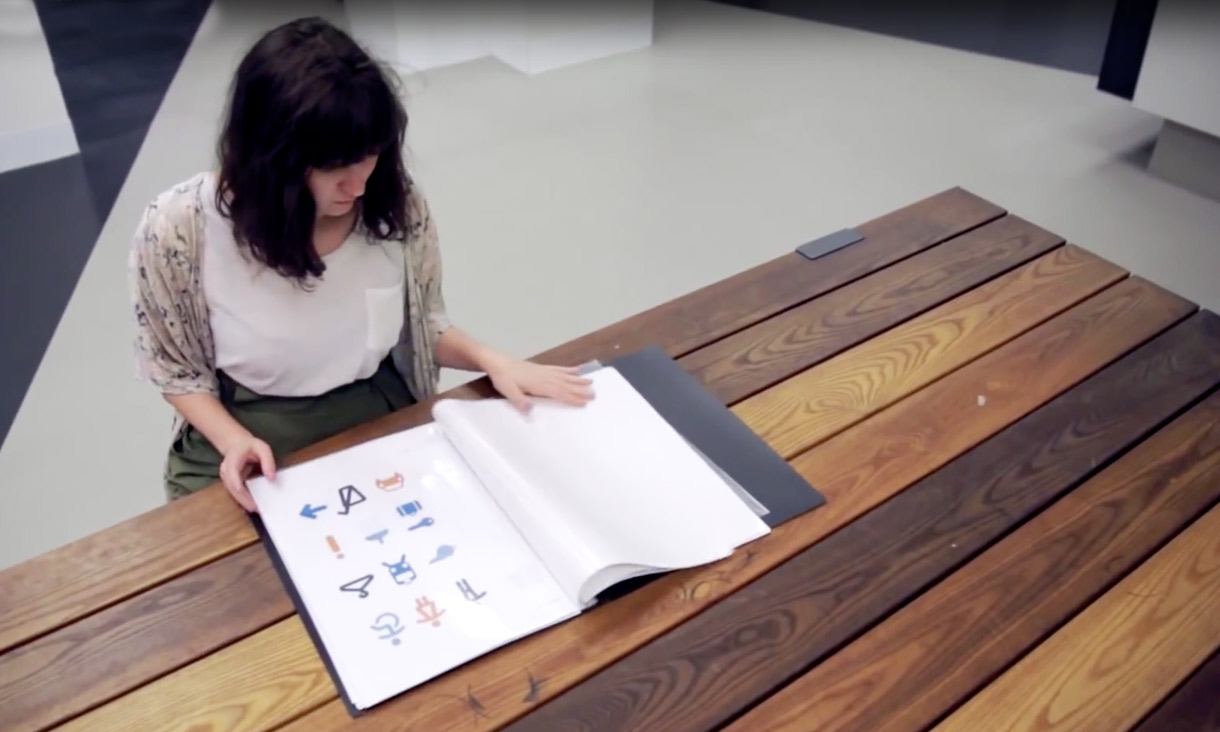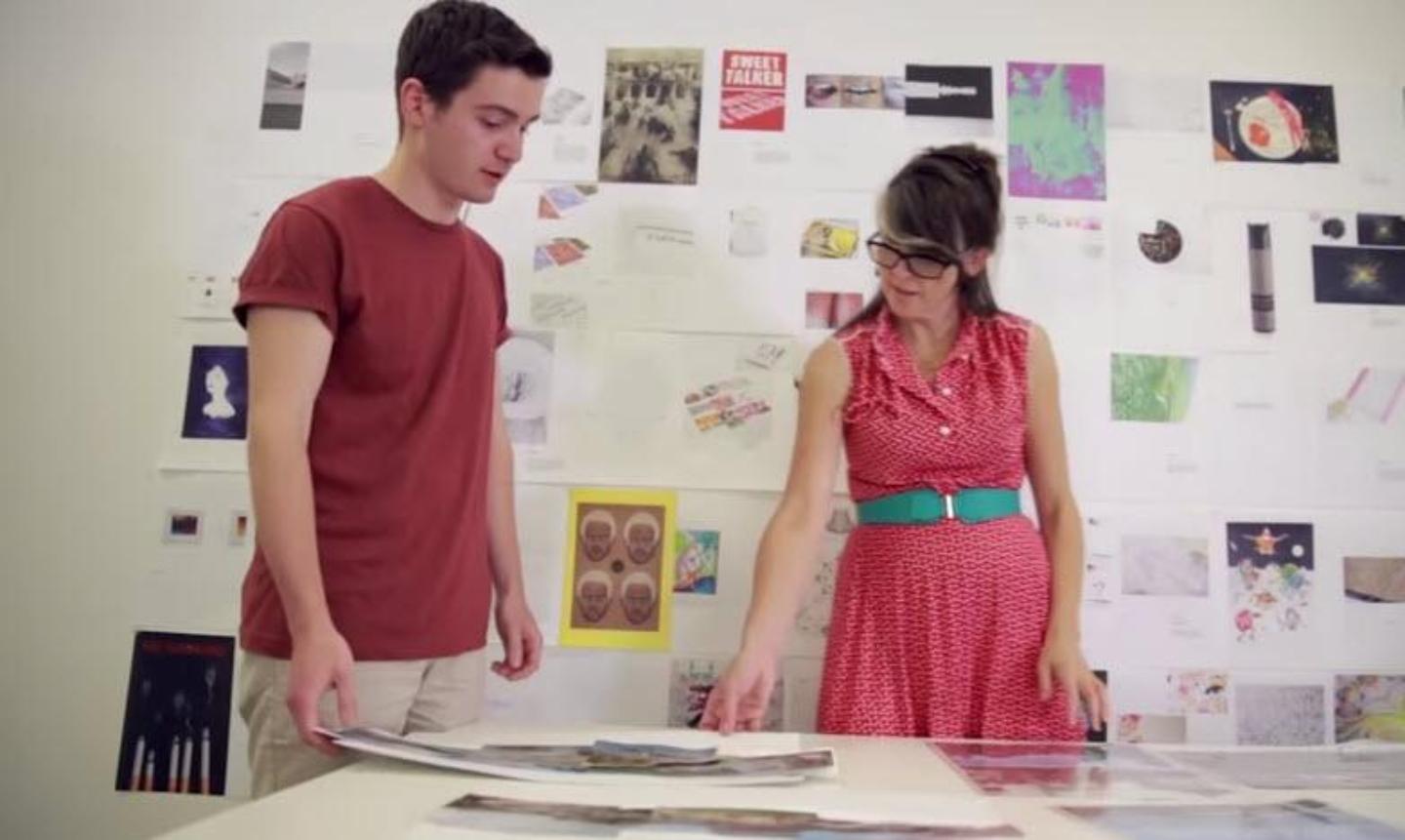TEXT ON SCREEN: Art and design selection interviews. Advice on how to prepare for an interview and ways to make the process easier. RMIT logo.
AUDIO: Ambient music.
VISUAL: Maddy stands it a white, art classroom address the camera. Intercut with shots of an RMIT letter. A caption reads: “Maddy Davidson, Interior design student, RMIT”.
MADDY SPEAKS: When I found out that I was shortlisted for the interview I was really, really excited. I screamed, I hugged everyone that was near me (chuckling). Yeah, it was really exciting.
VISUAL: Asa stands facing the camera. A caption reads: “Asa Kremmer, Landscape Architecture student, RMIT University”. Intercut with scenes of Asa and Maddy talking together.
ASA SPEAKS: Yeah, the interview was quite confronting but at the end of the day we were very motivated to succeed in what you love and what you’re passionate about.
VISUAL: Eliza stands facing the camera. A caption reads: “Eliza Mills, Photo imaging student, RMIT University.” Intercut with a shot of feet nervously tapping.
ELIZA SPEAKS: When I realised that I was shortlisted for an interview, I felt amazing but I also felt so nervous. I was sweaty and scared and I wondered whether I actually wanted to go but I knew photography was what I wanted to do so I had to do it, despite my nerves.
VISUAL. Phillippa standing to left of frame in a lecture hall. A caption reads: “Phillippa Murray, Lecturer, Interior Design, RMIT University”. Intercut with scenes of a student interview. There are two interviewers smiling and going through a printed folio.
PHILLIPA SPEAKS: I really understand that the interviewing process can be quite intimidating, I usually get nervous in interviews, myself. But what I think is really important, is to remember that we're humans on the panel and actually, we're just really interested in you and what your interests are and how you might imagine yourself as part of the course that we’re running.
VISUAL: Craig standing the a lecture theatre, addressing the camera. A caption reads: “Craig Douglas, Senior Lecturer, Landscape Architecture, RMIT University”. As he speaks the words ‘Have an opinion’ appear on the right side on the screen.
CRAIG SPEAKS: In the interview process, it’s important to have an opinion. So it might be that you don't like some things and you like other things but the important thing is that you can tell us, maybe, why.
VISUAL: Close up of keyboard as someone types and images laid out on a table, intercut with Phillips addressing the camera. The text: ‘Research your area’ appears to her right.
PHILIPPA SAYS: Do some research, go and see exhibitions, go and see films, research different projects online whatever it is, be curious Explore things and come prepared to tell us about what excites you.
VISUAL: Eliza facing the camera. Intercut with scenes of young male showing his folio in an interview.
ELIZA SPEAKS: The advice that I’d give would be to just be confident about your work and be proud of what you’ve done because I think that’s something that a lot of people forget about, they’re just focused on yeah, will they like it? But, I think, you should be proud of your own work and I think you should like your own work and I think if you give off that confidence, you’re more likely to get in than if you’re not confident about your work.
VISUAL: Return to Phillipa facing the camera. As she speaks the words ‘Include work from outside of school’ appear to her right. Intercut with more interview and folio footage.
PHILLIPA SPEAKS: A thing that a lot of prospective students think, when they’re applying for a course, is that they really should focus on their VCE subjects. But when I’m sitting on a panel, I’m actually really interested in you as a person so I think it’s really good to bring along the work that you’ve done within a school context but also to bring along other things that might represent you as a person in a broader capacity.
VISUAL: Asa addressing the camera. Intercut with interview footage.
ASA SPEAKS: I was really surprised by my interview ‘cause it was a group interview and so at first, it was quite startling to find out that you were being interviewed with three other students and I thought the engagement with other students was really important to succeed in the interview.
VISUAL: Craig facing the camera. As he speaks, two different phrases appear on screen: “Interview formats may vary” firstly, and then “Prepare your own questions.”
CRAIG SPEAKS: You may be interviewed by staff, such as myself; you might also be interviewed by current students who can also give an insight into the course. So you can ask them questions, as much as we’re asking you questions.
VISUAL: Jan Henry-Jones standing in lecture hall addressing the camera. A caption reads: “Jan Henry-Jones, Lecturer, Design, RMIT University”.
JAN SPEAKS: When we look through your folio we’re often quite quick, it’s not disrespect; we understand what’s gone into it.
VISUAL: Candidate shows folio to interviewers.
CRAIG SPEAKS: There’s a lot of people that we’re interviewing, we might look at your work quickly but we know what we’re looking for.
VISUAL: Philippa stands, addressing someone off camera. As she speaks, the words “Tell us who you are” appear on screen.
PHILIPPA SPEAKS: A good tip is to bring ten minutes’ worth of really strong material that presents you in a broad and interesting way and then to use those to tell us a little bit about who you are.
VISUAL: Eliza arriving at RMIT campus, finding the room and looking through her folio.
ELIZA SPEAKS: ‘Cause I’d never been to the university before and I didn’t want to get lost I decided to come really early, so I think I was about an hour and a half early just to find where I am, to feel more comfortable before my interview.
VISUAL: Return to Craig standing facing the camera.As he speaks, the words “Enjoy yourself” appear on screen.
CRAIG SPEAKS: It’s important to remember that the interview process is not meant to be stressful. So make it easy on yourself, give yourself plenty of time to arrive before the interview process itself and you’ll ... you should enjoy it.
VISUAL: Fade to white.
TEXT ON SCREEN: Read the instructions for your interview carefully, Allow yourself time to find the interview room, Do some mock interview with friends or family, Prepare some questions to ask, Have opinions and ideas.
TEXT ON SCREEN: RMIT logo. www.rmit.edu.au
[END TRANSCRIPTION]




